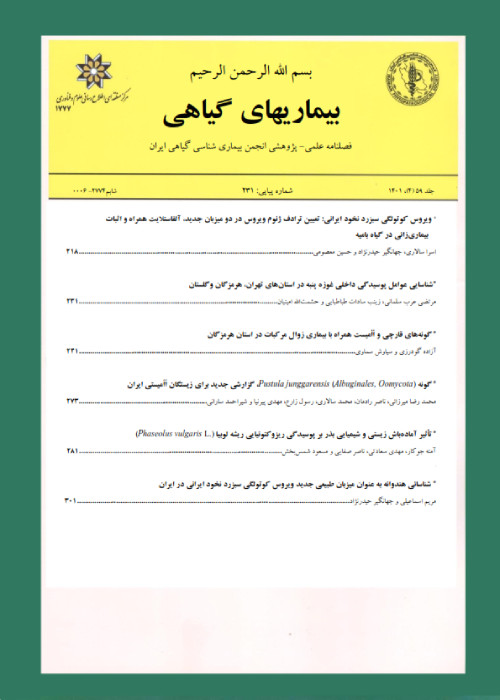OCCURRENCE OF FIRE BLIGHT CAUSED BY ERWINIA AMYLOVORA ON QUINCE IN KERMAN PROVINCE
Author(s):
Abstract:
Fire blight is one of the most destructive diseases of stone and pome fruits. The causal pathogen is Erwiniaamylovora, species in the family Enterobacteriaceae. Pears are the most susceptible, but apples, quinces and some other rosaceous plants are also vulnerable. In Iran, the disease has been reported for the first time in Baraghan in Alborz province (Zakeri & Sharifnabi 1991). Fire blight produces several different types of symptoms like blossom blight, necrosis of fruits and leaf tissues, and dark sunken cankers on stems and exudation of droplets of bacterial ooze from the affected plant tissues. Typical symptoms of fire blight were observed on quince (Cydonia oblonga) trees, in Shahrbabak in Kerman province in 2013. Dieback of terminal shoots and dark necrotic lesions on immature fruits were among the major symptoms observed. Samples containing regions of dead and healthy tissues were washed, macerated in drops of sterile distilled water and bacteria were isolated on sucrose nutrient agar (NAS) medium. After 72 h of incubation at 27°C, single whitish and round colonies were purified by sub-culturing on eosine methylene blue agar (EMB agar). Results of morphological and biochemical tests, demonstrated that the bacterium belongs to Enterobacteriaceae (Schaad et al. 2001). Pathogenicity was tested by injecting healthy young quince shoots with a 10-μl bacterial suspension of 107CFU/ml. Controls were injected with sterile distilled water. Shoots were kept at 27°C and 80 to 100% relative humidity. Dark brown-to-black lesions were observed five days after inoculation on the inoculated shoots. The bacterium was reisolated from the lesions formed on the inoculated shoots. No lesions were observed on the controls. All of the twenty strains used in tests for identification, produced white colonies on NAS, were gram-negative, induced a hypersensitive reaction in tobacco (Nicotiana tabacum L. ‘White Burley’) leaves, did not produce a fluorescent pigment on medium B of King and did not grow at 37°C. On the basis of the symptoms, colony morphology and biochemical features, the pathogen was identified as E. amylovora. To our knowledge, this is the first report on the incidence of fire blight on quince in Kerman province.
Language:
Persian
Published:
Iranian Journal of Plant Pathology, Volume:51 Issue: 2, 2015
Pages:
277 to 280
magiran.com/p1481552
دانلود و مطالعه متن این مقاله با یکی از روشهای زیر امکان پذیر است:
اشتراک شخصی
با عضویت و پرداخت آنلاین حق اشتراک یکساله به مبلغ 1,390,000ريال میتوانید 70 عنوان مطلب دانلود کنید!
اشتراک سازمانی
به کتابخانه دانشگاه یا محل کار خود پیشنهاد کنید تا اشتراک سازمانی این پایگاه را برای دسترسی نامحدود همه کاربران به متن مطالب تهیه نمایند!
توجه!
- حق عضویت دریافتی صرف حمایت از نشریات عضو و نگهداری، تکمیل و توسعه مگیران میشود.
- پرداخت حق اشتراک و دانلود مقالات اجازه بازنشر آن در سایر رسانههای چاپی و دیجیتال را به کاربر نمیدهد.
دسترسی سراسری کاربران دانشگاه پیام نور!
اعضای هیئت علمی و دانشجویان دانشگاه پیام نور در سراسر کشور، در صورت ثبت نام با ایمیل دانشگاهی، تا پایان فروردین ماه 1403 به مقالات سایت دسترسی خواهند داشت!
In order to view content subscription is required
Personal subscription
Subscribe magiran.com for 70 € euros via PayPal and download 70 articles during a year.
Organization subscription
Please contact us to subscribe your university or library for unlimited access!


